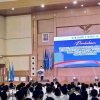Phenomenon, Many researchers tend to focus solely on numbers without meaning or narratives without data, causing research outcomes to lose balance between empirical validity and interpretive depth. Assumption, Combining quantitative and qualitative approaches provides a more holistic understanding of research since empirical data are strengthened by deep narrative contexts and more humanistic interpretations. Gap, Many studies still rigidly separate quantitative and qualitative approaches, resulting in partial findings that fail to complement each other and depict research reality holistically and meaningfully. Purpose, This paper aims to explain the importance of integrating quantitative and qualitative approaches so that research yields objective, meaningful findings that can comprehensively and contextually portray phenomena.
First : Quantitative data measure objectively, while qualitative data seek deep understanding; both complement each other to provide a comprehensive research picture. Research variables include independent, dependent, moderating, and mediating variables that are interconnected to understand relationships, influences, and mechanisms in educational research. The four measurement scales---nominal, ordinal, interval, and ratio---determine the appropriate type of statistical analysis to produce valid and accurate data. Validity ensures that instruments measure precisely, while reliability guarantees consistency---both are essential for research that is valid, accurate, and trustworthy.
Second : The population includes all research subjects, while the sample represents the population to obtain valid, efficient, and generalizable data. Sampling techniques are divided into two: probability sampling for objective generalization and non-probability sampling for in-depth data based on research considerations. Research instruments include questionnaires, observations, interviews, tests, and documents to ensure data validity, reliability, and alignment with research objectives. Pilot testing and content validity ensure that research instruments are accurate, valid, and relevant, providing reliable data for educational decision-making.
Third : Quantitative methods---using questionnaires, tests, and documentation---produce objective numerical data for analysis, evaluation, and educational decision-making. Qualitative methods---using interviews, observations, and document analysis---explore meaning, experiences, and educational managerial dynamics in depth and contextually. Strategies to maintain data accuracy include triangulation, instrument testing, enumerator training, and systematic documentation to ensure the validity of educational research. Data collection ethics emphasize respondent consent, confidentiality, transparency, and freedom to ensure research integrity, fairness, and scientific honesty.
Fourth : Pearson, Spearman, and Kendall correlation analyses measure the strength and direction of relationships among educational variables without directly explaining causality. Simple and multiple linear regression analyses measure the influence of independent variables on dependent ones, helping to identify dominant factors in educational management objectively. The interpretation of statistical results links data to research contexts, explaining the meaning of findings, policy implications, and their contributions to improving educational quality. Presenting data through tables, graphs, and narratives facilitates interpretation, enhances clarity, and supports evidence-based educational policy.
The entire research process involves understanding data and variables, applying valid data collection techniques, conducting correlation and regression analyses, and presenting results through tables, graphs, and narratives to produce valid, meaningful findings that support evidence-based educational policies.
_________
*) This paper is summarized from the Teaching Material for the Course Research Methodology Management Part 6, taught by Prof. Dr. A. Rusdiana, M.M.
Follow Instagram @kompasianacom juga Tiktok @kompasiana biar nggak ketinggalan event seru komunitas dan tips dapat cuan dari Kompasiana. Baca juga cerita inspiratif langsung dari smartphone kamu dengan bergabung di WhatsApp Channel Kompasiana di SINI







